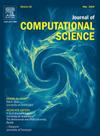Enhanced metabolite-disease associations prediction via Neighborhood Aggregation Graph Transformer with Kolmogorov–Arnold Networks
IF 3.7
3区 计算机科学
Q2 COMPUTER SCIENCE, INTERDISCIPLINARY APPLICATIONS
引用次数: 0
Abstract
Metabolites are essential products of cellular chemical reactions, critical for sustaining life and reproduction. Research shows that metabolite concentrations in patients differ from those in healthy individuals, making metabolite-based disease prediction crucial for diagnosis and treatment. To address the limitations of current computational methods in accuracy and interpretability, we propose a novel Neighborhood Aggregation Graph Transformer method (AGKphormer). This method enhances link relationships by optimizing the minimum nuclear norm using the Alternating Direction Method of Multipliers (ADMM) and incorporates Fast Kolmogorov–Arnold Networks (FastKAN) to improve both accuracy and interpretability. We first construct a heterogeneous network based on the correlation and similarity between metabolites and diseases. Then, we utilize the ADMM algorithm to enhance link relationships by solving the minimum nuclear norm, reducing sparse relationships between nodes and providing richer features for neural network learning. For the features learned by the graph convolutional network (GCN), we employ a Graph Transformer augmented with FastKAN to learn long-range dependencies. This approach enables global feature embedding and addresses GCN’s smoothness issue while enhancing interpretability. Through five-fold cross-validation, AGKphormer achieved average AUC and AUPR values of 97.32% and 97.34%, respectively, outperforming most methods and demonstrating its effectiveness in predicting disease-related metabolites. Additionally, case studies further confirm that AGKphormer is a reliable tool for discovering potential metabolites.
基于Kolmogorov-Arnold网络的邻域聚集图转换器增强代谢物疾病关联预测
代谢物是细胞化学反应的基本产物,对维持生命和繁殖至关重要。研究表明,患者体内代谢物浓度不同于健康个体,这使得基于代谢物的疾病预测对诊断和治疗至关重要。为了解决当前计算方法在准确性和可解释性方面的局限性,我们提出了一种新的邻域聚集图变换方法(AGKphormer)。该方法通过使用乘数交替方向法(ADMM)优化最小核范数来增强链路关系,并结合快速Kolmogorov-Arnold网络(FastKAN)来提高准确性和可解释性。我们首先基于代谢物与疾病之间的相关性和相似性构建了一个异构网络。然后,利用ADMM算法通过求解最小核范数来增强链路关系,减少节点之间的稀疏关系,为神经网络学习提供更丰富的特征。对于由图卷积网络(GCN)学习的特征,我们使用了一个增强了FastKAN的图转换器来学习远程依赖关系。这种方法可以实现全局特征嵌入,并在增强可解释性的同时解决GCN的平滑问题。通过5次交叉验证,AGKphormer的平均AUC和AUPR值分别为97.32%和97.34%,优于大多数方法,证明了其预测疾病相关代谢物的有效性。此外,案例研究进一步证实,AGKphormer是发现潜在代谢物的可靠工具。
本文章由计算机程序翻译,如有差异,请以英文原文为准。
求助全文
约1分钟内获得全文
求助全文
来源期刊

Journal of Computational Science
COMPUTER SCIENCE, INTERDISCIPLINARY APPLICATIONS-COMPUTER SCIENCE, THEORY & METHODS
CiteScore
5.50
自引率
3.00%
发文量
227
审稿时长
41 days
期刊介绍:
Computational Science is a rapidly growing multi- and interdisciplinary field that uses advanced computing and data analysis to understand and solve complex problems. It has reached a level of predictive capability that now firmly complements the traditional pillars of experimentation and theory.
The recent advances in experimental techniques such as detectors, on-line sensor networks and high-resolution imaging techniques, have opened up new windows into physical and biological processes at many levels of detail. The resulting data explosion allows for detailed data driven modeling and simulation.
This new discipline in science combines computational thinking, modern computational methods, devices and collateral technologies to address problems far beyond the scope of traditional numerical methods.
Computational science typically unifies three distinct elements:
• Modeling, Algorithms and Simulations (e.g. numerical and non-numerical, discrete and continuous);
• Software developed to solve science (e.g., biological, physical, and social), engineering, medicine, and humanities problems;
• Computer and information science that develops and optimizes the advanced system hardware, software, networking, and data management components (e.g. problem solving environments).
 求助内容:
求助内容: 应助结果提醒方式:
应助结果提醒方式:


